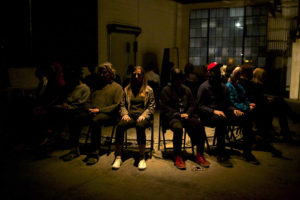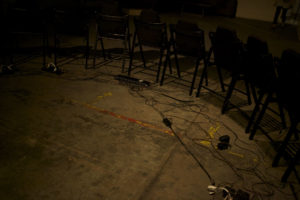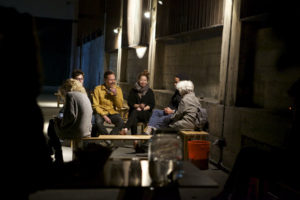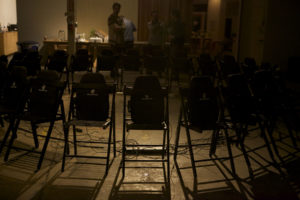Ben Vida – Damaged Particulates
- Ben Vida interviewed by Ellie Hunter
Ellie Hunter: So tell me about Damage Particulates, the performance that you put on at 356 S. Mission. How would you characterize the piece and how did you curate the musical material?
Ben Vida: Damaged Particulates is a live sound piece that oscillates somewhere between installation and performance. In this edition I use both a PA and 24 SubPacs, which are individual tactile sub-bass delivery systems. Working with the SubPacs has been interesting – they are very specific and I wanted to use them in a deliberate manner. I didn’t want to simply take pre-existing material and illuminate the sub-elements. Rather, I wanted the pads to become a voice of their own within the composition. So if you think of all the different synthesized voices that are being played through the sound system as a set of sonic materials that come together to create a voice, the SubPacs have their own voice that has their own logic and trajectory through the piece.
EH: Is this the first time that you’ve intervened with the audience in such a direct, physical way?
BV: There’s always a lot of physicality in the music I’ve made, but these objects, the SubPacs, are especially direct. I do have an ongoing project with a partner Jeff DeGolier, called Metal Fatigue Music. We have a minivan with a sub-bass speaker system in it that Jeff built out and I write the compositions for. We have people come and sit in the minivan and experience this really playful and heavy bass composition. Certain frequencies will cause the hubcap to shake, and other frequencies will cause the rearview mirror to shake. So this idea of a very body-experience is something that I’m interested in, an I see Damaged Particulates is kind of a further exploration of that kind of delivery.
EH: To what extent do you consider the audience when you’re making music that doesn’t interact with them in such a physically direct way? Do you think of the audience as part of the musical content in any way?
BV: So much of the music that I make deals with thresholds and often pushes into kind of unusual aural phenomena. One reason I feel it is important that I am present when presenting a piece of music, even if it is a fixed piece and all I am doing is making small adjustments to the volume and eq, is that I want the audience to know I am experiencing the piece with them – that I am receiving the same intense sonic experience. What an audience brings to a performance is their expectations of what they are going to experience. In some ways their expectations become a content of its own. It acts to inform how they receive my work.
EH: Your work is often described as being ‘experimental’ or ‘abstract.’ In your opinion, what constitutes a piece being experimental? Do you think of sound as being abstract or representational?
BV: It can be both, but I like to work with sounds I consider to be completely abstract. Of course each individual brings their own history of listening that informs what certain sounds will evoke for them. I also understand that once it’s out of my studio it’s out of my hands…. And people often use experimental to describe sounds that are dissonant or forms that are abstract, but that’s kind of a catchall usage and maybe not all that accurate. For me, for something to be experimental, one should be working towards an unknown of some sort. When I am working in this fashion, the final result — the piece — is almost just a by-product of the process.
EH: So it’s almost like using the word literally — like music as a way to experiment with thought.
BV: Yep. And I think engaging in expanded composition — taking a musical idea that may not be best realized in the aural realm, but perhaps is best realized as a video, or as a sculpture, or as an essay creates a space for this kind of experimental practice to thrive. It’s a space to ask new questions and discover new systems of production.
EH: So do you think that there’s usually a system that’s best suited to the specific idea?
BV: Right now I’m almost more interested in what the different mediums mean to the system, than in which system is best for which medium. For example, I want to make a video and I know what the input is and I know what the output is, and so I ask myself, “What’s the system that’s gonna get me from that input to that output?” And in a way that constructing of the system becomes the compositional part of the piece. And sometimes it doesn’t work, but that’s interesting too. I don’t really think about things as “good” or “bad” anymore; it’s just more about the intention, the process, the amount of guts that goes into it all and enjoying the discovery of what is created.
EH: Have you been listening to the radio since you’ve been in LA?
BV: I have been. I love seeing what kind of track really hits on both coasts and which kind doesn’t. The production techniques within popular music still seems to be working on some sort of sonic forward edge. Maybe because it’s a producer’s music and that forward edge is built into the practice of being a producer – you’re always pushing. An artist like Beyonce or Katy Perry make really functional art but one built upon a foundation of sonic technological advancements. On top of that the songs just work so great. And when something functions really well, like a good toaster oven, it’s going to be appealing.
EH: One thing that’s funny about living in LA is feeling like I’m part of this cultural machine since I’m driving and listening to the radio so much. I’ll notice trends in this really intense way and can’t help but get obsessed with them…
BV: Yeah for sure – the tempo that those sorts of trends or tropes come through and then go out of style is fast enough that you can watch the waves come in. So you’ll be like ‘Oh yeah, there was that sound.’ And at this point things cycle back around so quickly that things you heard as a sonic trope or whatever like three years ago might be back. Which is interesting… it’s like the snake eating it’s own tail and it’s getting smaller and tighter with each rotation.
EH: Have you noticed that “hey, hey, hey, hey” track in the background of like every hip-hop song? Part of me feels like it’s telling me to drink Coca-Cola or something.
BV: Yeah totally… I think about that too. There was that song, you know that New York song? The Jay Z and Alicia Keys song…
EH: Empire State of Mind ☺.
BV: Right, Empire State of Mind. So obviously that was a pretty big song, especially in New York, and there’s something about that chorus, the way it is eq’d with the compression and the sustain of the voice, it carried so well and I found that there was a period in the city that if you were outside you were hearing that chorus everywhere. Like it was a drone in the city. And it was so finely tuned that if it was playing in a car or in someone’s apartment or out of someone’s phone you could hear it – it was so wild. That’s an amazing sound stamp, where you aren’t even hearing a melody, you’re just hearing a quality of sound, and you know it’s that song. I am always trying to produce the most resilient sounds I can so they will represent themselves clearly no matter what kind of sound system they are played through. That chorus was built to be quite resilient.
EH: In a past interview you did, you talk about the book Uncreative Writing by Ken Goldsmith and the malleability of content that musicians and visual artists are afforded.
BV: Yeah, I’ve always had a practice of writing that I’ve kept private, but has become a little less private in recent years. As I have been reconsidering how I want language to function in my work I have started to play with new ways of amassing content. For instance, even though I am such a fan of Robert Ashley I’m not going to try to emulate what he was able to do as a story teller, but there is an aspect of how language works rhythmically within his operas that I want to access. By approaching the use of language and the voice in a nonlinguistic way, I feel that I can access those aspects of his work. As an extension of this, and inspired partly by Kenneth’s book I’ve become interested in borrowed or repurposed textual content. This method of sampling preexisting content is something I do with sound and feel no creative qualms about it. What is the equivalent of sampling music or sourcing images off the internet? And sure William S. Burroughs and Brion Gysin developed the fold-in/cut up method and as well there are other precedence of text appropriation, but what Kenneth talks about in Uncreative Writing is that it’s so much more fluid of a process now because of “cut and paste”. The mass digitizing of text has contemporized the written word as a material and has allowed it to have the same kind of malleability that sonic elements have had for years.
EH: But in longer-form literature, that hasn’t really been done…
BV: Right, but I think that there’s no reason we can’t also receive that in the textual realm. So the hurdle is not as much the doing as it is the receiving. In terms of sound samples, I think as receivers, we accept that. So when we hear a hip hop song that samples a 70’s soul song, we accept it. And when we see an appropriated image, we accept it and we can read it, we can receive it. And that is something that the arts do so well — they facilitate an extending of society’s ability to read the unknown. It’s aestheticizing the unfamiliar to be more fluently received, so that learning to enjoy a challenging experience with art becomes just another thread of how we understand our senses.
EH: I’m interested in the titles of your pieces, particularly in Damaged Particulates and Slipping Control. To me, there’s something about them that references your level of authority over the piece. Could talk to me about what’s behind them?
BV: Slipping Control refers to what I perceive as the control paths that are used during creative process — what choice leads to the next choice, and so on. I like considering the idea of control within the architecture of a synthesizing system. You have an oscillator that’s controlled by another oscillator that’s routed to a VCA that’s controlled by a gate, and it’s a matter of connecting one thing to the next — decision to decision to decision. In the case of the Slipping Control project I’m using the same input for a number of different outputs, be it video or objects or a performance, and so from one output to the next the trajectory of the control path differs and what is influencing that trajectory continues to shift. Even from iteration to iteration an overall slippage starts to occur, so that the production of the video may act to control an element within the production of a painting, or the editing of an LP record. As this project has continued, the different versions have started to fold back on themselves and begun to influence the control paths of new iterations.
In terms of Damaged Particulates, the original idea comes from being interested in synthesis and sound. I like non-specific sound objects, as opposed to narrative sounds or sounds that evoke specific things. Language is a particulate system, it’s parts put together to communicate meaning. So I think a string of sounds together, even very abstract sounds, inevitably has a very evocative quality. I like the idea of taking the particulates and trying to have their interaction with each other be off, or be slightly damaged, as a way of further escaping representational sound. Another thing with Damaged Particulates is that at the time when I was starting to produce the sonic materials for the composition I was just coming out of six months of chemotherapy which I undergone to fight Hodgkin’s Lymphoma. This idea of a very physical structural damage or elemental damage is something that was on my mind. Not in the sense of unpacking some emotional trauma, but more just in terms of a curiosity about what the damage means, what the correction from the damage means, what structures that continue to function through damage. And with chemotherapy there is damage that is done through the process in that you have to wipe out a lot to take care of a very specific little. On the whole I’m not that interested in making work that’s closely based to my emotional life, but it’s ungenerous to think that it’s not always at least an aspect of how one creates.
- Ben Vida - Damaged Particulates (excerpt)
Performed at 356 S. Mission Road/Twooga Booga
February, 2015
Ben Vida
Damaged Particulates
at 356 S. Mission Road
Thursday, February 26
Friday, February 27
Saturday, February 28
Each performance of Damaged Particulates is limited to 24 attendees. All performances are now at capacity. Please email rsvp@356mission.com to be placed on the waiting list. Please indicate which date you’d like to attend, and which seating.
Damaged Particulates was originally commissioned for the New York edition of Unsound Festival and had its debut sold-out run at Phill Niblock’s performance space Experimental Intermedia in April, 2014.
It has since been presented at Leap Gallery, Berlin and at the Cricoteka Modern Art Museum, Kraków as part of Unsound (The Dream). This presentation marks the West Coast debut of “Damaged Particulates.”
Tags: Ben Vida





